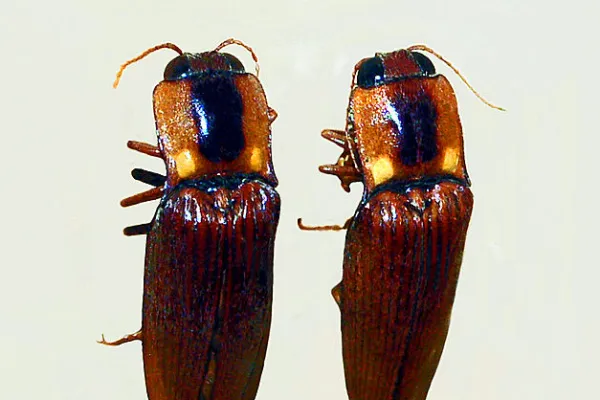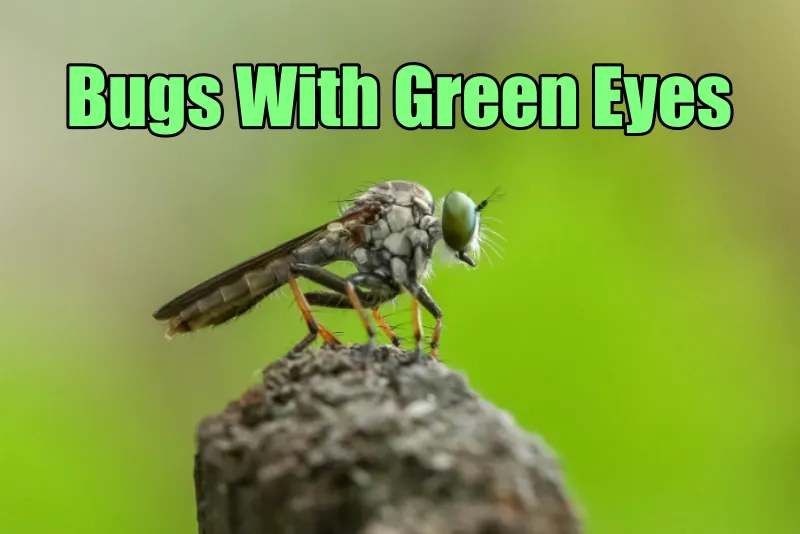If we talk about eyes, there are many colors, like blue, brown, green, and many more. But have you ever encountered any creature with green eyes? Do you ever notice bugs with green eyes? If not, here are a few species of green-eyed bugs you can find in your surroundings.
So let’s begin.
A List of 23 Bizarre Bugs With Green Eyes
1. Green Robber Fly

| Scientific name | Promachus vertebratus |
| Size | 30-35 mm |
| Identification | Seen with some reddish or copper casting |
Promachus vertebratus is a member of the Asilidae family, also known as the green robber fly. As its name suggests, this bug has green eyes. These bugs with green eyes have a beautiful iridescent green but are also seen with some reddish or copper casting.
This fly makes a buzzing sound while flying, and its bite can be painful if not taken seriously. So next time, if you see this fly around, stay conscious. Other than that, you can find this fly in the grasslands of North America and Mexico.
2. Pyrophorus noctilucus

| Scientific name | Pyrophorus noctilucus |
| Size | 20-40 mm |
| Identification | Glowing green eyes |
Next on our list is Pyrophorus noctilucus, a species of beetle that can reach around 20–40 mm in length. The green-eyed bug has serrate antennae with a uniform brown body coloration.
Also, the protonum of the beetle is long backward. Do you know the magical facts about this beetle?
Let us tell you that this beetle is among one of the brightest bioluminescent insect species. The eyes of the beetle look normal orange, but when they start glowing, they turn green.
3. Mountain mahogany fly
| Scientific name | Gymnochiromyia flavella |
| Size | Approx. 2 mm |
| Identification | Pale yellow body |
The mountain mahogany fly is another species of bug that has green eyes. This fly has the scientific name Gymnochiromyia flavella. Another interesting fact about this fly is that it got its name from where it was found.
You can commonly find this species on the land of mountain mahogany. They like to live in oak and chaparral habitats and on sandy soils.
This fly can grow to around 2 mm in length. Taking into account their appearance, they had a pale yellow body color and brown legs. Also, its eye color is green.
4. Pyrearinus candelarius

| Scientific name | Pyrearinus candelarius |
| Size | Approx. 20 mm |
| Identification | Yellowish or pale brown pronotum |
This species of beetle, found in Argentina and Brazil, is also a bioluminescent species of insect. The common body coloration is dark brown with large eyes and a yellowish or pale brown pronotum.
It emits bioluminescent light through two light organs at the prothorax and a large abdominal area, emitting green and yellow light. The beetles do not flash and also have bioluminescent eggs and pupae.
5. Peacock spider
| Scientific name | Maratus volans |
| Size | Approx. 5 mm |
| Identification | Colorful abdomen |
Ab is a species of jumping spider native to Australia, belonging to the genus Maratus.
They have a specialized visual system that allows them to see the full visible spectrum and ultraviolet range, enabling them to detect and pursue prey.
Males have colorful abdomen flaps used to attract females during courtship. Both sexes reach about 5 mm in body length.
6. Hine’s Emerald

| Scientific name | Somatochlora hineana |
| Size | Approx. 63 mm |
| Identification | Two yellow lateral stripes |
Hine’s emerald dragonfly has a unique appearance throughout its life, with nymphs having no distinctive features during the larval stage.
Adults have a distinctive dark-green thorax with two yellow lateral stripes, unique male and female reproductive structures, brown eyes for the first 1-3 days of adulthood, and emerald green eyes after the third day.
Their wings remain clear with amber coloring until the end of their lives, then become smoky. The average mature Hine’s emerald measures 2.5 inches in length and has a wingspan of 3.5 inches. Female dragonflies are slightly longer than males.
7. Common pondhawk
| Scientific name | Erythemis simplicicollis |
| Size | 36-48 mm |
| Identification | Metallic green sheen |
Erythemis simplicicollis, also known as the common pondhawk, is a dragonfly native to the eastern two-thirds of the United States and Canada. It is a pond-dwelling dragonfly with a bright green female and a blue abdomen.
The nymphs have green eyes and become dull olive green when they leave the water.
Over time, the abdomen turns bright green, the head takes on a metallic green sheen, and the male’s green changes to a duller shade of blue and finally a powdery bluish-grey.
The wings are distinctively veined and have dark margins near the apices. These bugs with green eyes can grow 36 to 48 mm in length.
8. Green-eyed flower bee

| Scientific name | Anthophora bimaculata |
| Size | 8-9 mm |
| Identification | Yellow face |
Anthophora bimaculata, also known as the green-eyed flower bee, is commonly found in the landscapes of North Africa, Russia, Ukraine, and Europe. These green-eyed bugs are reported to be 8-9 mm long and like to live in sandy areas.
Most of the male bees have narrow, light tergite bandages, a yellow face, and hairy middle legs. Females are Clypeus yellow with two large black spots, gray-yellow tomentose hairs, and light hair ties.
But the common factor among them is that both males and females have olive green eyes and a high flight sound.
9. Common Green-Eyed White

| Scientific name | Leptophobia aripa |
| Size | 30-45 mm |
| Identification | White and light green wings |
Next on the list is the common green-eyed white, a species of Leptophobia also known as Leptophobia aripa and green-eyed white.
It is a non-toxic bug commonly found in the land of Mexico, Central America, South America, and Southern Texas.
This green-eyed bug can grow up to 30–45 mm in length. They like to fly around Corolla because the pollen sticks to their fluffy hairs. As its name suggests, the bug has white and light green wings, sometimes grey too.
10. Australian Common March fly

| Scientific name | Tabanus australicus |
| Size | 13-15 mm |
| Identification | Gray wings |
Tabanus australicus, also known as the Australian common March fly, is a horsefly species in the Tabanus family, endemic to Australia and found in Queensland.
First identified in 1919, it is blackish-brown, 13–15 mm long, with gray wings, no setulate basicosta, and a stout proboscis.
11. Greenhead horse fly

| Scientific name | Tabanus nigrovittatus |
| Size | 38-63 mm |
| Identification | Scissor-like mouthparts |
Tabanus nigrovittatus, also known as the greenhead horsefly, is a biting horsefly found in coastal marshes and wetlands in the Eastern United States.
These smaller, housefly-like creatures are a significant pest to humans and animals, seeking blood protein to produce eggs.
Their bites are more painful than those of mosquitoes, as they cut a wound in the skin with scissor-like mouth parts and sucked the blood released through it.
12. Long-horned bee
| Scientific name | Eucera longicornis |
| Size | 9-15 mm |
| Identification | Shorter antennae |
Melissodes bees, also known as long-horned bees, are found in both rural and urban areas. Males have long antennae, while females have shorter antennae and abundant long-haired scopae on their hind legs.
These bees are known for darting between flowers in warmer months. Both males and females are hairy, often having striking blue or green eyes. Melissodes bees are part of the Apidae family.
13. Striped horse fly
| Scientific name | Tabanus lineola |
| Size | 10–16 mm |
| Identification | Pale median stripe |
Tabanus lineola, a species of Striped horsefly, measures 10–16 mm and is commonly found near larval habitats. Adults can be found anywhere, with larvae in wet soil.
Females have a pale median stripe on their abdomen, eyes with green bands, and a concolorous scutellum.
Males have similar body patterns but bare eyes with sharply differentiated upper and lower facets.
14. Twin-lobed deer fly
| Scientific name | Chrysops relictus |
| Size | 8-10.5 mm |
| Identification | Yellow-and-black body |
The twin-loved deer-fly is a horse-fly species with females with sharp mouthparts that feed on large mammals’ blood and humans’ blood. Males, lacking these mouthparts, feed on nectar.
Females wait in shady areas for prey, locating it by sight with their large compound eyes. The twin-lobed deer fly is beautiful, with a yellow-and-black body, patterned wings, and iridescent green-and-red eyes.
15. Great green bush cricket
| Scientific name | Tettigonia viridissima |
| Size | 28-42 mm |
| Identification | The stridulation organ is brown. |
Tettigonia viridissima, the great green bush cricket, is a large species of bush cricket in the Tettigoniinae subfamily. Adult males can grow up to 28–36 millimeters long, while females reach 32–42 millimeters.
The insect is typically green, with yellowish or yellow legs. Its stridulation organ is brown. Its long and thin antennae can reach up to three times the body’s length, distinguishing it from grasshoppers.
It’s often confused with Tettigonia cantans, which has shorter wings, and Tettigonia caudata, which has conspicuous black spines on its hind.
16) Giant Prairie Robber Fly
- Scientific name – Microstylum morosum
- Size – 35-50 mm
- Identification – white wing membranes, a reddish-brown body, and a uniform white pruinescence covering the head and thoracic dorsum
Once more, a robber fly! The largest one in North America, Microstylum morosum, is one of those strange bugs with green eyes. When it is on your property, you won’t be able to ignore it due to its enormous emerald-green eyes, sleek body that is practically hairless, and absurdly big size.
Robber flies are opportunistic hunters. We cannot ignore emphasizing their extended, powerful reddish-brown legs for grasping the prey and their bearded facial look for extra attention.
17) Hanging-Thief Robber Fly
- Scientific name – Diogmites esuriens
- Size – 17–48 mm
- Identification – white wing membranes, a reddish-brown body, and a uniform white pruinescence covering the head and thoracic dorsum
Robber flies, like this one in particular, are ambush predators! Of course, one of the most dramatic bugs with green eyes on our list is the hanging thief robber fly.
This one is less hairy and has a more brownish color with an even tone than the previous two. And given their impressive emerald eyes and translucent wings, we would be better off not calling them bizarre bugs!
Diogmites are charismatic predators who frequently dangle by one or two legs as they eat their prey. Though they can be challenging to identify, they are widespread in the Southeast, particularly in Florida.
18) Sand Wasp
- Tribe – Bembicini
- Size – 2 to 2.5cm
- Identification – Black and yellow, or white and black, frequently arranged in a banded, bee-like pattern, while numerous have faint, greenish patterns
With 20 genera, the Bembicini, also known as sand wasps, are a large tribe of crabronid wasps.
Bembicines are predators that feed on several kinds of insects. Within each genus, the type of prey that is taken tends to be consistent, with flies (Diptera) being the most frequently taken.
While most sand wasps are yellow-black, some have vivid green eyes and are black and white in tone, which explains why they are on this list.
19) Candy-Striped Leafhopper
- Scientific name – Graphocephala coccinea
- Size – 6.7–8.4 mm
- Identification – a conical head with remarkable horizontal red and blue stripes running over the forewings
Brightly colored leafhoppers, such as Graphocephala coccinea, are indigenous to North and Central America, ranging from Canada south to Panama. Common names for this species include red-and-blue, red-banded, candy-striped, and scarlet-and-green leafhoppers.
Adults are 6.7–8.4 mm long, with bright yellow coloring on the head, legs, abdomen, and other areas. They also have striking blue (or green) and red (or orange-red) stripes on their wings and the top of their thorax.
The question now is: Why does this one show up here? Given that its eyes are not entirely green. Strangely, though, a green line that contrasts with the other colors goes through its head, thorax, and wings, right through its eyes as well which explains its appearance on the list.
20) Mantidfly
- Family – Mantispidae
- Size – about 5–47 mm
- Identification – front half looks like a mantid, while the other half resembles a lacewing
Mantispidae is a family of small to moderately large insects in the order Neuroptera. Their common names include mantidflies, mantispids, or mantid lacewings.
They made our list because of their brilliant metallic green eyes, which can occasionally sparkle with varied hues. Around 400 species are found in various genera worldwide, particularly in the tropics and subtropics.
Moreover, this is among the strangest insect groups, with a majority of these mimic wasps being brownish with hints of green, yellow, and occasionally red.
21) Swamp Cicada
- Scientific name –Neotibicen tibicen
- Size – 1 to 2 inches
- Identification – distinctive membranous, green, translucent wings that extend past the abdomen and green, brown, and black markings on the top of the thorax
The swamp cicada or morning cicada is the name given to this predominantly green and black bug with extremely deep dark green eyes. Neotibicen tibicen is active primarily in the morning; hence its common name, the morning cicada.
These insects are exclusively cold-blooded, and they only become active in the morning after warming up their bodies in the light. Additionally, the swamp cicadas are the only species native to the eastern states that are commonly found in marshy or swampy environments on low weedy plants and bushes, as well as in dry upland meadows and overgrown fields.
22) Sunflower maggot
- Scientific name – Strauzia longipennis
- Size – about 6mm
- Identification – The wing’s orange-to-brown bands, which typically form a clear F-shaped pattern close to the wing tip, contrast with the body’s yellow-to-orange hue
These bugs have incredibly odd green alien eyes contrasting sharply with their yellow bodies. Strauzia longipennis, the sunflower maggot, is a large species of tephritid fruit fly.
These bugs are quite fascinating despite their strangeness, such as their eyes being bulged out and their wings being transparent, however, possessing some visible pattern.
23) Bush Katydid Nymph – Scudderia
- Scientific name – Scudderia septentrionalis
- Size – 5-38 mm
- Identification – Specific black & white patterned wings
The northern bush katydid, or Scudderia septentrionalis, is a species of phaneropterine katydid belonging to the Tettigoniidae family. And on the other hand, the Phaneropterinae, or leaf katydid, is a subfamily. Since their look is so evident, they are also referred to as round-headed katydids or fake katydids.
North America is home to this species. Here’s another fascinating fact: the sound they produce when they sing together is rather nice. They do sing, yes.
Conclusion
So here are some of the bugs with green eyes. You might be thinking we all saw these bugs around us but didn’t notice such details closely, and some of you also wanted to know more about them.
These creatures are a perfect example of nature’s creation. Their beautiful sheens and eye color will definitely make you feel delighted. If you want to know more about them, then stay tuned to HowItSee.
Reference:
- Wikipedia
- Bugguide
- https://www.beeandbloom.com/blog/bee-spotlight-long-horned-bee
- https://pictureinsect.com/wiki/Leptophobia_aripa.html
Also Read:

As a content writer, I like to write about different niches. I have a curiosity about nature and animals. And like to learn about them. Through my writing, I like to share my experience and knowledge with you. I hope you are enjoying it too.
